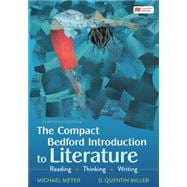About This Book
The Compact Bedford Introduction to Literature: Reading, Thinking, and Writing
ISBN: 9781319331825
The Compact Bedford Introduction to Literature is a comprehensive textbook designed for introductory literature courses. It's a go-to resource for students and educators alike, offering a detailed exploration of literary elements and meeting scope and sequence requirements for typical introductory literature courses.
Who Uses It?
Primarily, this book is used by students and instructors in introductory literature courses at the college and university levels. It's also a valuable resource for anyone interested in understanding and analyzing literature, including professionals looking to refresh their knowledge or expand their understanding of literary principles.
History and Editions
The 13th edition of The Compact Bedford Introduction to Literature has been updated to address user feedback, incorporating the latest discussions on diverse literary works and approaches. This edition includes detailed updates on reading and writing about literature, addressing representation issues in examples and discussions. It also includes a mix of classic and contemporary works drawn from diverse periods and cultures, building a strong foundation in literary analysis before asking students to apply what they've learned.
Author and Other Works
Michael Meyer and D. Quentin Miller are the authors of The Compact Bedford Introduction to Literature. Michael Meyer is known for his engaging, conversational writing style and his ability to explain complex literary concepts clearly and simply. D. Quentin Miller brings his expertise in literature to the text, ensuring that it remains current and relevant.
Key Features
- Comprehensive Coverage: The book covers core literary elements such as fiction, plot, character, and setting, with detailed explanations and examples.
- Diverse Literary Works: The text includes a mix of classic and contemporary works from diverse periods and cultures.
- Interactive Tools: The Achieve platform provides interactive features such as e-book access, highlighting and notetaking tools, and online course materials.
- Supportive Resources: The book includes resources for reading and writing about literature, as well as preface for instructors and introduction to reading imaginative literature.
Detailed Information
ISBNs and Formats
- Bound Text: ISBN-13: 9781319331825
- E-book: ISBN-13: 9781319527013
- Package with Achieve and Paperback: ISBN-13: 9781319543747
- Rental Options: Available for 3 months and 4 months rentals from various retailers[1][2][3].
Publication Details
- Publisher: Bedford/St. Martin's
- Publication Date: April 7, 2025
- Number of Pages: Varies by format (paperback format not specified)
- Language: English
- Item Weight: Varies by format
- Dimensions: Varies by format
Other Editions and Formats
- 13th Edition: Available through Bedford/St. Martin's and other retailers[1][2][4].
- Related ISBNs:
- 9781319527013 (E-book)
- 9781319543747 (Package with Achieve and Paperback)
- 9781319331832 (Online course materials with iClicker Student)
This detailed information section provides a quick reference for all the available formats and sources for The Compact Bedford Introduction to Literature, making it easier to find and access the book in the preferred format.









